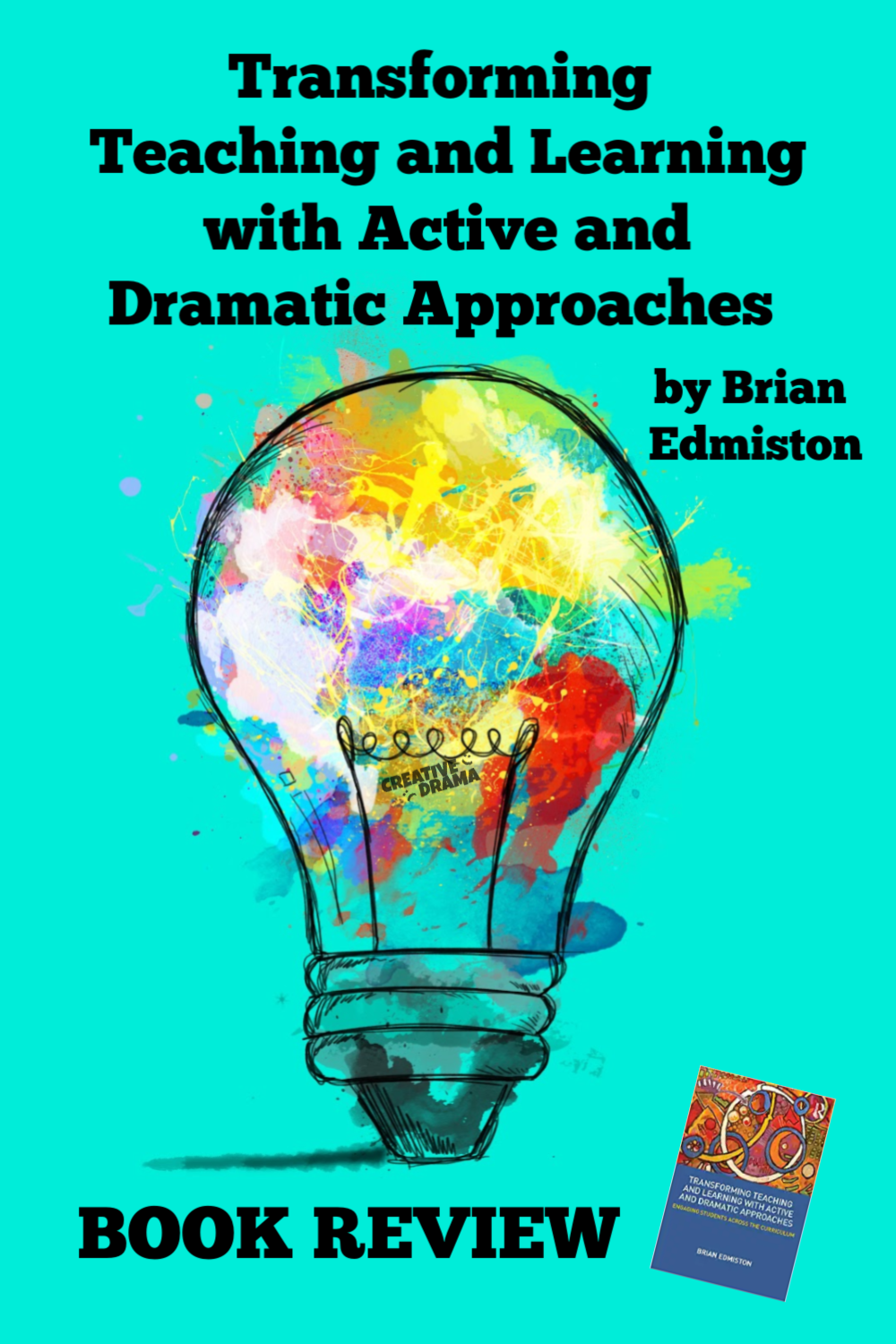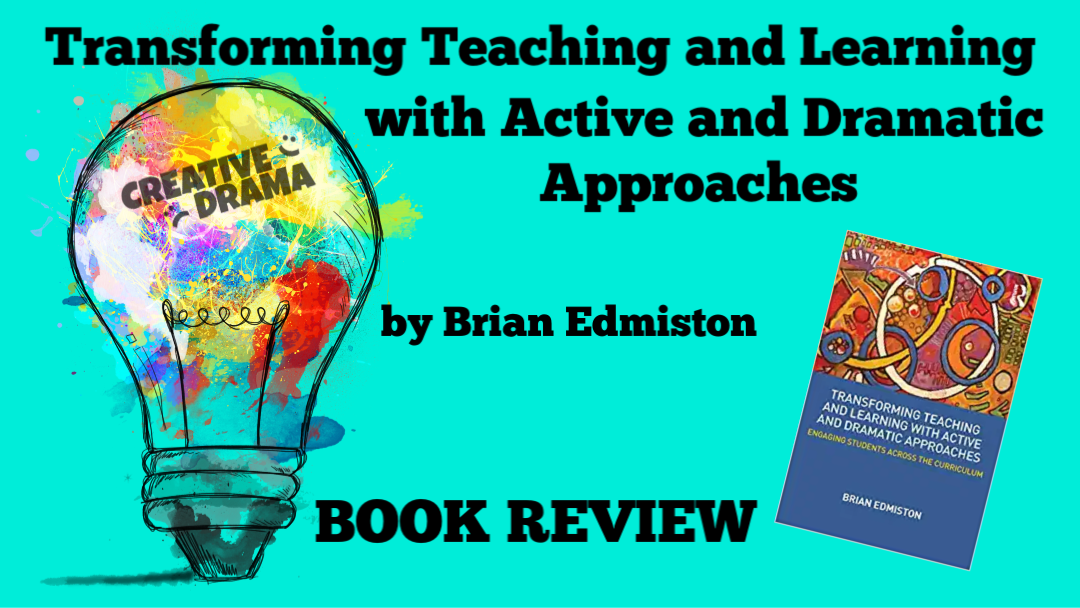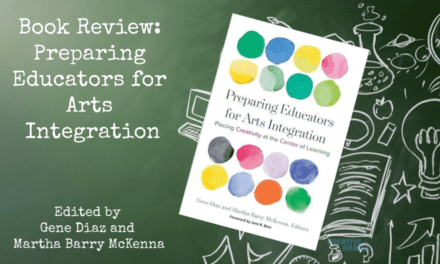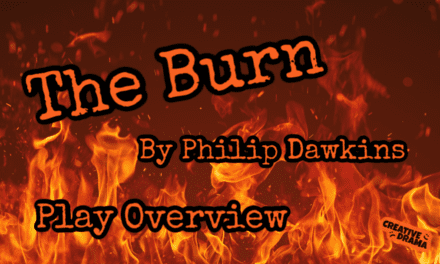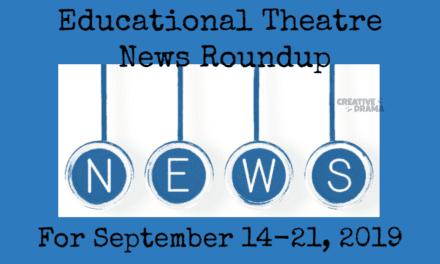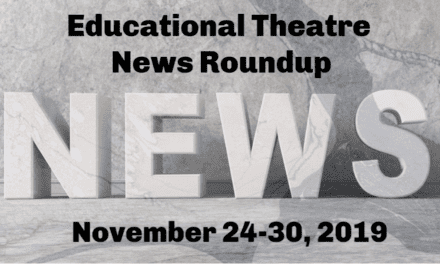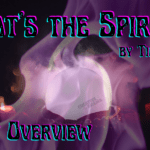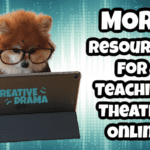Contents
INTRODUCTION
Transforming Teaching and Learning with Active and Dramatic Approaches: Engaging Students Across the Curriculum by Brian Edmiston packs dozens of useful ideas into an educational text. Edmiston balances educational philosophy, theories of learning, and teaching methodologies with actual classroom experiences.
I’ve been doing a lot of reading on Integrating Drama into Other Subjects in the past year. Arts Integration is becoming more prevalent in education as teachers look for more ways to meet learning standards and make concepts “stick” in students’ minds. While many of Edmiston’s activities would fit into Drama Integration, his book reaches beyond theatre education and Arts Integration into a holistic teaching methodology.
I suggest readers have some background knowledge about constructivist pedagogy before delving into Transforming Teaching and Learning with Active and Dramatic Approaches. As in reading Preparing Educators for Arts Integration, knowing about Lev Vygotsky and Mikhail Bakhtin is helpful in understanding Edmiston’s perspective.
ORGANIZATION
At 342 pages, Transforming Teaching and Learning with Active and Dramatic Approaches is daunting. But part of the reason for its length is Edmiston’s inclusion of multiple print modalities. There are lots of photographs, illustrations, graphic organizers, charts, tables, and insets. Edmiston uses bulleted lists when appropriate and emphasizes concepts in boldface.
There are 7 chapters, the titles of which serve as “steps” in how to “transform” one’s teaching. In addition, Edmiston includes the following sections:
- Foreword
- Preface
- Afterword
- References
- Index
- There are also “Notes” at the end of each chapter giving further information about topics Edmiston discussed earlier.
There isn’t a plethora of scholarship on the “active and dramatic approaches” Edmiston advocates for in his book. That means he frequently references his own articles; in fact, only Dorothy Heathcote has more entries in the References section than Edmiston does!
CHAPTER 1: Be Active and Dramatic in Dialogue to Transform Learning
In Chapter 1: “Be Active and Dramatic in Dialogue to Transform Learning,” Edmiston covers using tools to mediate learning, dramatic reflection, and authentic, open-ended, substantive, and polyphonic conservations (among other concepts).
The main lesson examples Edmiston uses to demonstrate “active and dramatic dialogue” are based on pieces of literature. The nursery rhyme “Jack and Jill” gets a class of preschoolers to conduct a first aid inquiry (“How can we make Jack feel better?”). Edmiston states that for younger students, the “single live event and its aftermath” (27) of “Jack and Jill” makes it an accessible text.
Character work – teacher-in-role, students-in-role – for Robert San Souci’s Brave Margaret provides a way for middle school students to explore the implicit meanings in the text and illustrations. First, the students create tableaux based on the illustrations in Brave Margaret, a story about a monarch’s quest to find a knight to defeat a giant. Edmiston gives them photocopied pages of the picture book to help recreate the moment. I think this would be particularly effective with students unused to dramatic exploration, ones for whom abstract thinking is a challenge, or those who have aphantasia. Edmiston provides a transcript of his conversation with a group in tableaux and the rest of the class to show how he guides the tableau actors to “hold” their positions.
Then, the students form “Consciousness Threes” to help them work out characters’ decision-making processes. One participant is the character, another is the “pro” side of the choice, while the third is the “anti.” The polyphonic conversation that ensues gives each student a chance to contribute. A “teachers-in-role” exercise follows, because there are graduate students observing the class who can take on the parts of the “lost-the-battle-with-the-giant” warriors.
Edmiston places several tables, bulleted lists, insets, and graphics in Chapter 1, including a list for “initiating and maintaining conversations,” a table of Active and Dramatic Learning Modes, and simple tips on getting started.
CHAPTER 2: Build Community
Early in Chapter 2, Edmiston quotes a respected educator who says building community is a continual process: “you can’t build community in a day-and-a-half” (73). Tracey Bigler-McCarthy is correct, but she teaches at a school that is pedagogically constructivist. Creating a community takes time – “weeks before such socially demanding work,” (88) students were playing cooperative games. In a typically-scheduled high school, students have 6 to 7 different teachers, who may (unlikely!) or may not be on board with building community. With curriculum and testing pressures, grades to submit, and schedules to keep, it could be challenging to establish strong ties without sacrificing some other aspect of one’s teaching.
One of the methods of building community is having students complete ensemble tasks; Edmiston provides a table detailing the “core dimensions” of these. They are more collaborative and cooperative than most “group work” activities.
Edmiston also examines a 9th-grade English class in an urban high school for the ways their teacher, Megan Bollinger, builds community with a student body facing social and economic challenges.
There’s an inset in Chapter 2 explaining the game “There’s a Strong Wind Blowing For/The Sun Shines on All Those Who” that has some great examples from Macbeth.
INCLUSION
Edmiston shares some of his early teaching experiences in order to demonstrate that “Community Building is Possible with Any Group.” He details a seminar with Dorothy Heathcote in a school for persons with developmental disabilities. Edmiston also recounts some moments at Highland Park Elementary in Grove City, Ohio which has a “child-initiated, project-based” philosophy. I do want to know whether the interventions suggested by colleagues for the student who spent 2 days under a desk “snapping at people like a dog” worked, but Edmiston leaves that part out of his recollections!
A list of ways to model inclusion on pages 115 and 116 has useful tips, the challenge for teachers is juggling multiple adaptions within a classroom of 25 students.
RESISTANCE
Understanding that it’s often more challenging for older students to accept collaborative and cooperative work, Edmiston collects suggestions for “Anticipating Resistance” (112) he developed with some of his graduate students. One of these references “The Goldilocks Rule,” which some educators know as the Zone of Proximal Development (ZPD).
Also, there’s an inset on “Using Informal Assessment as an Inclusive Community Building Tool” which has methods for quick, whole-group feedback. Sometimes reluctant students don’t participate, and this is a way to respond “to possible discomfort” (119)
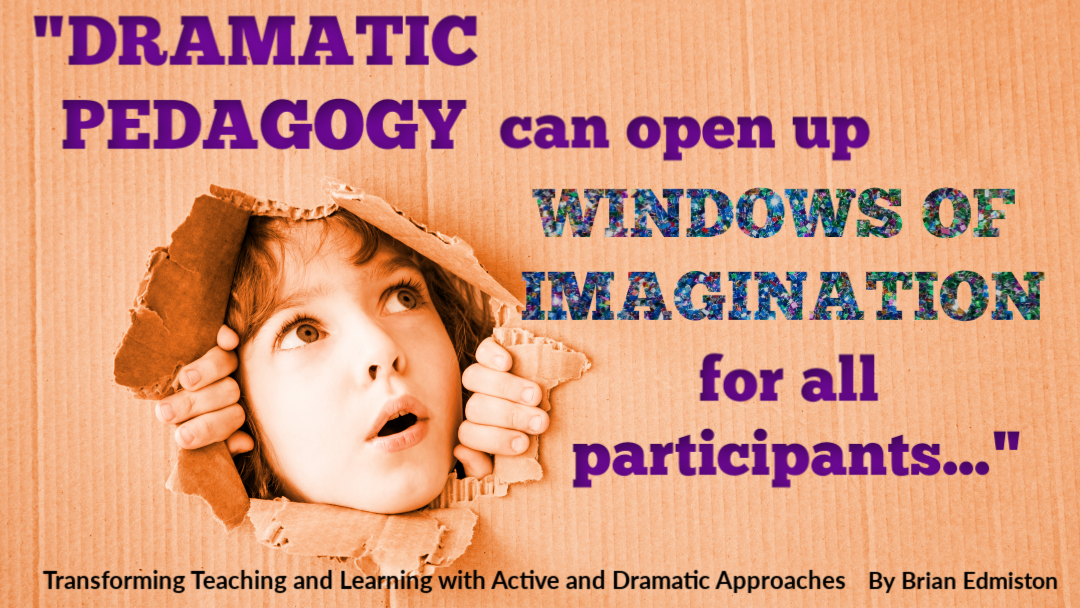
CHAPTER 3: Plan for a Journey of Exploration
In Chapter 3, Edmiston shows how unit/lesson planning and execution works when teachers are striving for student-driven learning through active and dramatic approaches.
Edmiston helps Megan Rodgers Frazier use William Steig’s Amos and Boris in a first-grade classroom to achieve the educational objectives of understanding text sequencing (for ELA – the “academic” curriculum”) and exploring “How do we make friends?” for the social curriculum.
Teachers need to determine, with student input, the topic, goals, intended outcomes, and beginning tasks for the unit. They need to consider students’ background knowledge as well as the potential lack thereof. Determining background knowledge has always been a challenge for me; I’ve handed groups cards with fairy tales on them so they could do “album tableaux” and had not a single student out of five know the story!
Once they’ve done the above, teachers have to find “ABCD Events likely to Hook Young People” (inset on page 142).
Edmiston continues to supply lots of tables and lists for easy reference:
- Tasks to Build Background Knowledge – page 143
- Structuring for Student Choice – Table 3.1, page 148
- A Few Things I Remember About Building Background Knowledge – page 158
- Tasks Designed to Develop Changed Understanding – page 158
- Dramatic Strategies Chart – Table 3.2; page 171
- List of Mediating Tools – page 149
The List of Mediating Tools is a 21-item recounting of the strategies used in the Amos and Boris sessions – which were three 2-hour-long periods for a 32-page book – 8 of the strategies on the list were dramatic ones. There are also plenty of photographs from the Amos and Boris sessions and graphic organizers.
Gems of Knowledge from Chapter 3:
- Frazier points out that “If you only use the drawings in a book, kids, without a lot of background knowledge, can get stuck with an inadequate image.” (151)
- Edmiston reminds “teachers who seem impatient with learning how to use dramatic approaches that just as it took time to learn, for example, how to read aloud to children or lead a discussion with a particular group, so it takes time to become comfortable with,and knowledgeable about, being hotseated by students.” (173)
- Similarly, Frazier says, “It’s taken a few years, but now I plan for integration.” (132)
- Edmiston recommends starting with the active and dramatic strategies that are “High Teacher Structure,” because those are the least socially demanding of the students. Once students develop comfort and confidence, then teachers can phase in the “Medium” and “Low” ones.
- Frazier’s advice to teachers beginning their active and dramatic approaches journey: “Start slow. Start short. Give students choice from day one.” (183)
CHAPTER 4: Teach for Authentic and Critical Inquiry
Now that Edmiston’s introduced many active and dramatic strategies, he wants to examine the sequencing of the tasks to explore essential questions through disciplined inquiry.
Chapter 4 also addresses Fred Newmann’s “Inseparable Dimensions of Authentic Pedagogy.” These are: Disciplined Inquiry, Construction of Knowledge, and Value Beyond Success in School –
Disciplined Inquiry
Here, Edmiston features the disciplined inquiry of Lorraine Gaughenbaugh’s 4th-grade students who are studying…Shakespeare’s Macbeth. It’s not really clear if the unit is a literary toe-dipping or wading or a full-on immersion into the text.
In their study of Macbeth, Gaughenbaugh’s students begin with an event outside of the play’s narrative: the preparations happening at Inverness to accept the wounded after the battle against Norway and the Thane of Cawdor. As castle servants, the students address the open-ended question of how they’ll care for the injured soldiers, actively by setting up a makeshift hospital in the room (“the castle”) and compassionately by considering how the wounded will be treated.
The students already had background knowledge about medieval warfare. Gaughenbaugh was working on scaffolding their understanding of the situational perspectives of Duncan and the other nobles so that students could understand why they trusted Macbeth, even if the students (because of dramatic irony) did not.
Edmiston’s list of Questions That Are Likely to Sustain Dramatic Dialogic Inquiry gives concrete examples from Macbeth in addition to describing the qualities of such questions.
Authoring More Complex Understanding
This is the section on Construction of Knowledge; Edmiston states that the objective is making “higher-order thinking” visible (201). Learners “create new meaning using multiple processes.” (201) These processes somewhat parallel Bloom’s Taxonomy, though Edmiston does not explicitly reference Bloom.
At Gaughenbaugh’s school, “experimental and design approaches to author understanding and high-order thinking through inquiry” are common. (201) Edmiston demonstrates how “Authoring Understanding with Students happens when they embody “ideas in imagined events.” (205)
Value Beyond Success in School
In this section, Edmiston provides a transcript of his and Gaughenbaugh’s discussion with the students as they are all in-role. The learning objective of “compassion” seems to be going well until Edmiston tells the servants that one of the dead soldiers they’ve accepted into the castle IS A NORWEGIAN.
Then, one of the students – in response to the possibility of leaving the corpse on the battlefield for the vultures – says that THEY SHOULD FEED THE NORWEGIAN TO “POOR PEOPLE WHO NEED FOOD.” (211)
Amazingly, Edmiston keeps his cool and redirects the conversation to “what would be the RESPECTFUL” thing to do in the situation. He adoes not comment on the suggested cannibalism, or, ask the student to “step out” of role. He really keeps to his “no judgement” rule!
Another activity the class participated in was an expanded “Consciousness Threes” in which half the class took on the group role of Lady Macbeth’s inner voice(s). While Gaughenbaugh played Lady Macbeth, the class smoothly dialogued with her and each other, working out her reasoning for inciting murder.
Again, Edmiston emphasizes that the students in this class HAD TIME “to become immersed in the world of Macbeth and explore inquiry questions in context from multiple perspectives.” (216) If only more teachers had the time for these in-depth experiences!
CHAPTER 5: Be Tactical and Strategic to Transform Teaching
In Chapter 5, Edmiston relates the concepts of teaching strategically and tactically. Strategic teaching is attending to the broad goals of classroom practice, while tactical teaching is attending the specific tools one’s using. Edmiston believes that in order to do achieve both goals, a teacher has to be willing to improvise with students: in dialogue, in roles, in dramatic situations.
I made a note while I was reading this chapter that Edmiston’s pedagogy for active and dramatic approaches was “a lot.” Teachers need to be okay with going slow on these approaches and accept that it will take time to develop the expertise and ease that Edmiston demonstrates in both his writing and teaching. He even shares a “mis-take” he made in an early attempt at dramatic dialogue with students that ended with the swift death of his character!
Edmiston’s working example for this chapter is a third grade class studying Sharon Creech’s Love That Dog, a novel in poems. Because the work deals with the life and death of a beloved pet, Edmiston foregrounds an awareness of the students’ emotional states during the lesson. For example, he allows students to “cover their ears” if they don’t want to hear “the sad ending” of a particular poem.
Teaching Modes
Edmiston covers the four core teaching modes for active and dramatic learning:
- Facilitating Groups
- Instructing/Directing
- Facilitating Individuals
- Dialogizing
He explains each, then a few pages later, arranges a table of “Active and Dramatic Teaching Strategies Categorized by Teaching Mode” that lists techniques, exercises, and games under each of the four. The only thing missing from the chart is the page number on which one can find “Zip Zap Zop” or the other items on the list, though they are in the index.
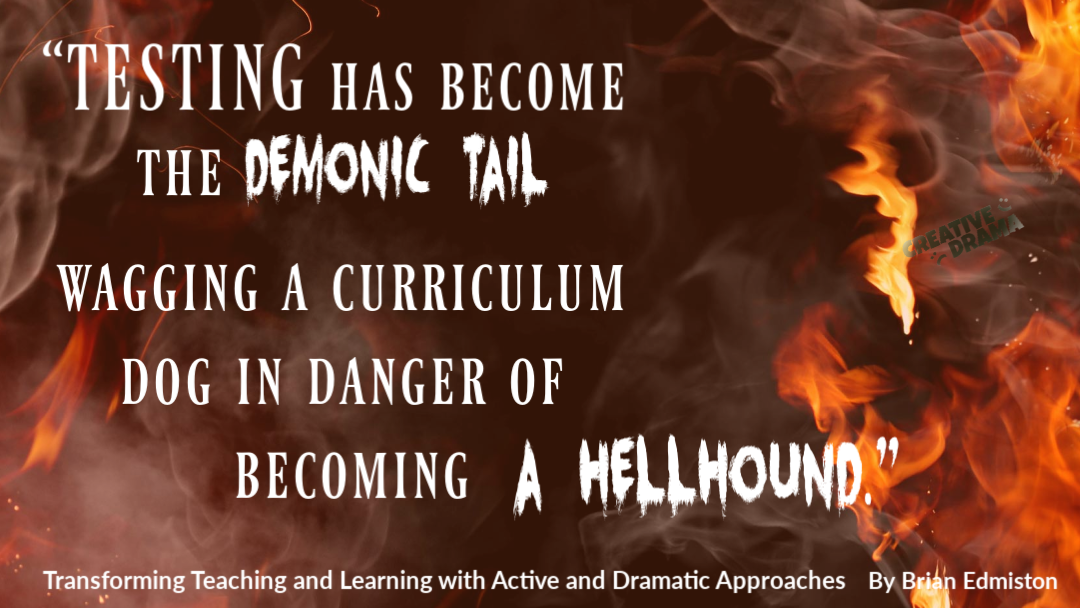
CHAPTER 6: Assess What You Value in Achievement
Chapter 6 covers assessment, including informal, formal, dialogic, formative, and summative. At the beginning of the chapter, Edmiston discusses educators’ feelings about the topic of standardized, high-stakes testing – the kinds which, here in the the U.S. governments require and ranking websites use to determine the “best” schools – and they are mostly negative. Edmiston expresses it as “Testing has become the demonic tail wagging a curriculum dog in danger of becoming a hellhound.” (263)
Edmiston’s interested in authentic assessment; he views the thinking required for standardized tests as “inauthentic,” “decontextualized,” and “disembodied.” (263) As in previous chapters, he provides multiple lists and charts to help the read organize all the content he’s covering. He shares an assessment rubric for participation in class (268).
The classroom experience Edmiston uses to illustrate authentic assessment is Megan Bollinger’s 9th grade English classroom in a high-poverty school where minority students make up the majority of the student body. Bollinger’s class studies The Other Wes Moore: One Name, Two Fates by Wes Moore. It’s a great choice of literature for Bollinger’s class; she was able to pick a text she surmised would engage students’ interest. The students take on the roles of investigators, lawyers, and the accused during their unit. Bollinger connects the class explorations to Common Core Standards while using authentic assessments.
Authentic Assessment in Writing
In addition to the transcript of the courtroom enactment, there are January and May writing samples from a student. I wanted to see the full six-paragraph “writing-in-role,” but instead compared a single sentence from January to two sentences from May. The student’s sample from January was a single run-on sentence with serious spelling and grammatical errors; the writer’s point was obscured by the quality of the writing. In May, the student still wrote run-on sentences, but they made more sense and clearly communicated points he wanted to make. There were still spelling errors and only end punctuation marks. While he improved, the writing would not have achieved a “Proficient” score on a state test; he’s a ninth grader, so he has a few more years to improve.
But will he have an English teacher, or any teacher, in the ensuing years who will utilize authentic assessment, let alone help him make meaning through active and dramatic approaches?
CHAPTER 7: Embrace the Complexity and Simplicity of Dramatic Pedagogy & Afterword by Cecily O’Neill
In his concluding chapter, Edmiston shares some final thoughts on dramatic pedagogy and provides personal anecdotes supporting its use in all levels of education.
Cecily O’Neill, author and world-renowned authority on drama in education, shares several concepts from Dorothy Heathcote that apply to active and dramatic approaches, and reemphasizes the importance of keeping students’ learning active.
RECOMMENDATION
Transforming Teaching and Learning with Active and Dramatic Approaches: Engaging Students Across the Curriculum is designed for elementary and middle school teachers who teach across multiple subjects, or secondary teachers of most subjects. Theatre teacher-directors will find it useful if they find themselves stuck in a content rut, where students are reading plays and studying theatre history but not truly engaging with the material.
But Transforming Teaching and Learning with Active and Dramatic Approaches is not only a pedagogical tome; I noted towards the end of Chapter 2 that Edmiston had already presented a dozen different games and activities for teachers to try with students. By the time I was through the book, there were well over 50.
The book is priced like a college textbook. If you’re familiar with dramatic pedagogy and know that it’s going to be a cornerstone in your teaching, it’s worth the price; Transforming Teaching and Learning will provide you with plenty of evidence and ideas to support your work. If this is a new but intriguing idea, you may want to peruse a copy through a library if one’s available before making your purchase decision.
If you want to read more now, you can find Edmiston’s own chapter summaries here, and there is a preview of Transforming Teaching and Learning with Active and Dramatic Approaches available on Amazon.
NOTES AND QUESTIONS
Edmiston recommends Pam Bowell and Brian Heap’s Planning Process Drama (2001) as “the most useful book on active and dramatic planning that I know.” (125) – Probably worth checking out!
The epigram to Transforming Teaching and Learning with Active and Dramatic Approaches is “Never forget to remember what you’d forgotten you knew.” I don’t know who said this or wrote this; a Google search only turned up the Google Book excerpt for this title!
Does the teacher need to fundamentally change her educational philosophy to engage in these practices?
My feeling is YES; this isn’t something one can “dabble” in. But it doesn’t need to happen all at once, and a teacher doesn’t have to abandon her on-paper job responsibilities in order to incorporate these techniques.
How Can Teachers Use Active and Dramatic Approaches While Meeting Prescribed Curriculum and Standards?
I have two quibbles with Chapter 3. First, both Frazier and Edmiston advise choosing a text based on desired learning outcome and the interests of the class. Maybe curriculum and content choices are more flexible in Frazier’s school/grade level than they are in many schools across the U.S.? I know that in most schools, texts must be pre-approved by administration, and choosing them after you’ve met your students doesn’t give the text enough time to go through the review process.
Second, Edmiston states that as a teaching artist doesn’t have to “cope” with “increasing surveillance of schooling and extended control” of teaching. Also, he says he’s “not naïve about “increasing constraints on curriculum and pedagogy.” However, he challenges teachers by asking “Whom do you want running your classroom? Is it the textbook publishers, the testing industry, district objectives, or you and the young people?” (129)
In some teaching positions, navigating Edmiston’s question is a matter of meeting the expectations of the “powers that be” OR not “running your classroom” at all because you’ve lost your job for not adhering to standards. It would be better to show how teachers might meet requirements, standards, and goals within the curriculum while using the active and dramatic approaches Edmiston advocates.
How Can Teachers Use Active and Dramatic Approaches to Improve Test Scores?
One of the missing pieces in Chapter 6 “Assess What You Value in Achievement” is the recognition that regardless of educators’ opinions of standardized tests, students must take them, and their results can impact their present and future educational possibilities. Can Edmiston’s active and dramatic approaches, along with authentic assessments, help students improve the skills that are being assessed on standardized tests? Can teachers “assess what they value” and still satisfy administration’s desire for achievement and progress?
I think the answer is “yes.”
For example, Bollinger’s students write letters to the parole board in-role as supporters of Wes Moore and as people who think Moore should stay in jail. The dramatic situation they’re writing within is one in which the quality of writing can contribute to the success of the endeavor. Clear, well-written, amply-supported letters would be more likely to sway parole board members than misspelled, poorly-argued, unintelligible ones. It’s possible that students who succeed in writing an effective letter of support could transfer their skills to an inauthentic writing sample for a state test or the writing section of the SATs. The question of the most effective ways of getting students to recognize, and use, the skills they’ve gained will need to be investigated.
From the activities described in Chapter 6, The Other Wes Moore seems to be the story of a man perhaps wrongly convicted of murder. However, it’s simultaneously the author’s biographical story of his own success and his investigation into how he and “the other” Wes Moore had so many things in common in their childhoods and yet had such different paths in life. Wes Moore the author is a Rhodes Scholar, veteran, and White House Fellow with multiple college degrees. His parallel story might provide the opportunity for students to embody the role of the Wes Moore who likely was successful on standardized tests.
ABOUT THE AUTHOR
Brian Edmiston is a Professor of Drama in Education at The Ohio State University. He has degrees from the University of Bristol, the University of Newcastle upon Tyne, and The Ohio State University. He is the author of many academic articles, and is the author of:
- Forming Ethical Identities in Early Childhood Play (2008)
- With Jeffrey Wilhelm: Imagining to Learn: Inquiry, Ethics, and Integration Through Drama (1998)
- With Richard Beach, Gerald Campano, and Melissa Borgmann: Literacy Tools in the Classroom: Teaching Through Critical Inquiry Grades 5-12 (2010)
Edmiston grew up in Northern Ireland in the 1950s and 60s, where his “mis-educative” experiences in schools led him to work towards more just and equitable education for his students. He cites Mikhail Bakhtin and Dorothy Heathcote as strong influences on his educational philosophy.
Edmiston maintains a blog on OSU’s site with many posts; he also has a guide to Transforming Teaching and Learning with Active and Dramatic Approaches: Engaging Students Across the Curriculum there.
